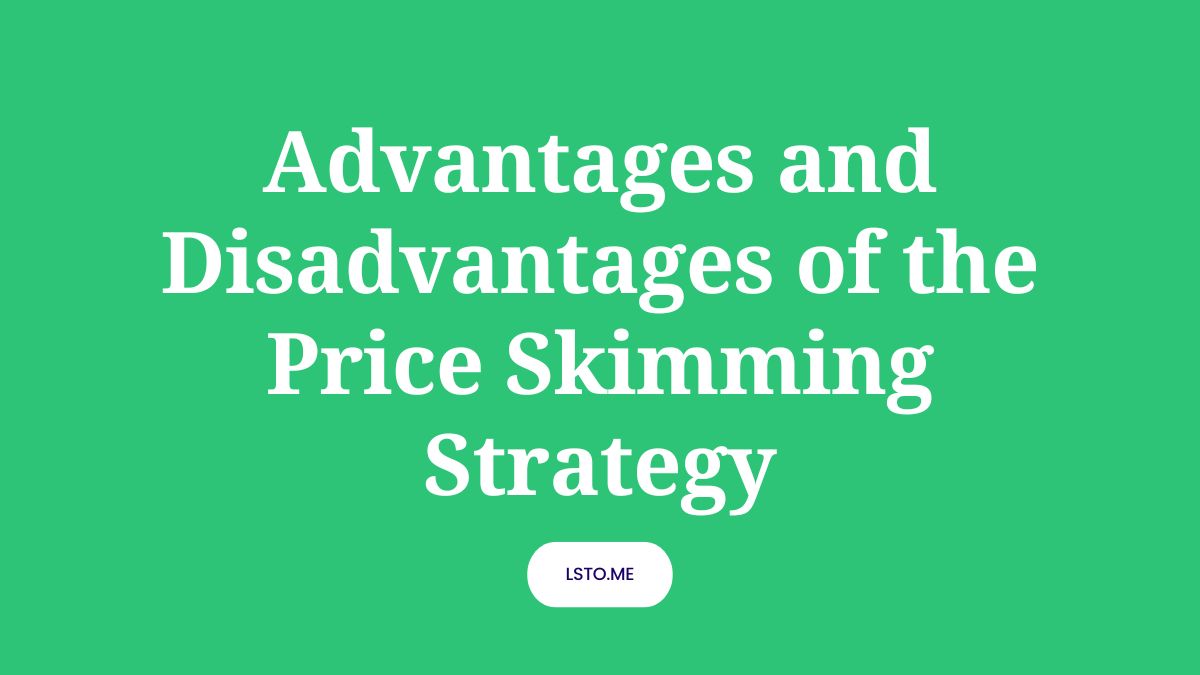
The price skimming strategy involves setting a high price for a new product or service to maximize profits before competitors enter the market. While this approach can generate substantial revenue, it also comes with risks. In this post, we’ll explore the advantages and disadvantages of the price skimming strategy to help you decide whether it’s a viable option for your business.
Advantages of Price Skimming
1. Revenue Maximization:
Price skimming is an effective strategy that can help businesses maximize their revenue. This approach involves charging a premium price for new products or services during the initial phase of their introduction to the market. This pricing tactic enables companies to generate substantial revenue before competitors enter the market and prices begin to decrease.
One significant advantage of price skimming is that it allows businesses to recoup their research and development costs quickly. By setting high prices, companies are often able to cover their expenses within a shorter period than if they were offering lower-priced products.
2. Perceived Value:
Perceived value is a powerful tool that companies can use to their advantage when launching a new product. By setting a high price, businesses can create the perception that their product is of high quality or exclusive, which can attract early adopters and generate buzz around the brand. This strategy is known as price skimming, and it has proven to be very effective in certain industries.
One of the main advantages of price skimming is that it allows companies to recoup their initial investment quickly. This is particularly beneficial for startups and small businesses that have limited financial resources. By pricing their products at a premium, these companies can generate revenue faster and start building their brand reputation sooner rather than later.
3. Rapid ROI:
Another advantage of price skimming is that it helps companies achieve rapid ROI (return on investment). By charging high prices initially, businesses can generate significant profits in a short period. This influx of revenue can help them pay off their initial investments more quickly and free up capital for future projects.
Disadvantages of Price Skimming
1. Market Share Limitations:
Market share is a critical aspect of any business’s long-term success. While setting a high price for a product can seem like an attractive strategy, it can lead to significant limitations in market share. This limitation occurs because higher prices often limit the number of customers who are willing to buy the product, which can ultimately impact the business’s overall revenue and profitability.
One of the primary disadvantages of price skimming is that it makes products less accessible to lower-income consumers. When businesses set higher prices for their products, they often create barriers that prevent lower-income individuals from purchasing them. As such, these customers may opt for cheaper alternatives or simply choose not to purchase anything at all. This limited audience reduces overall sales volume and can significantly impact potential profits.
2. Competitive Pressure:
When setting prices, companies often use a technique called price skimming to maximize profits. Essentially, this means that they set the initial price of their product high to take advantage of early adopters who are willing to pay a premium for the latest and greatest technology. However, while this strategy can yield significant profits in the short term, it also comes with some significant disadvantages.
One major disadvantage is that competitive pressure can be intense. Competitors may enter the market sooner than anticipated, or the high price may incentivize competitors to develop similar products more quickly than they otherwise would have. This can lead to increased competition and decreased market share for the company using price skimming as its pricing strategy.
3. Early Adopter Disillusionment:
In the world of product marketing, price skimming is a popular strategy used by businesses to maximize profits during the initial stage of a product launch. This involves setting a high price point for the product and targeting early adopters who are willing to pay a premium for the latest technology or innovation. However, this approach may come with several disadvantages – one being early adopter disillusionment.
If the product fails to deliver on its perceived value, early adopters may feel cheated by the high price they paid and be less likely to recommend it to others or purchase from the same company in the future. They may even leave negative reviews online, which can have a significant impact on a brand’s reputation and sales performance. In some cases, this disillusionment can also spread beyond early adopters and affect mainstream consumers who were waiting for reviews before making their own purchasing decisions.
4. Negative Brand Impact:
Price skimming is a strategy used by companies to maximize their profits when launching new products or services. This approach involves setting high prices during the initial phase of the launch, and then gradually reducing them as time goes on. While this may seem like a smart business move, it can have negative consequences for the company’s brand reputation if customers feel that they are being exploited.
One major disadvantage of price skimming is that it can lead to a perception of greed or unfairness among customers. If people believe that a company is taking advantage of their loyalty by charging exorbitant prices, they are likely to view the brand in a negative light. This can result in decreased sales and customer retention rates, as well as damage to the overall reputation of the business.
Conclusion:
Price skimming can be a lucrative pricing strategy for businesses looking to maximize profits, but it also has its downsides. By understanding the advantages and disadvantages of price skimming, businesses can make an informed decision about whether it’s a viable option for their product or service.